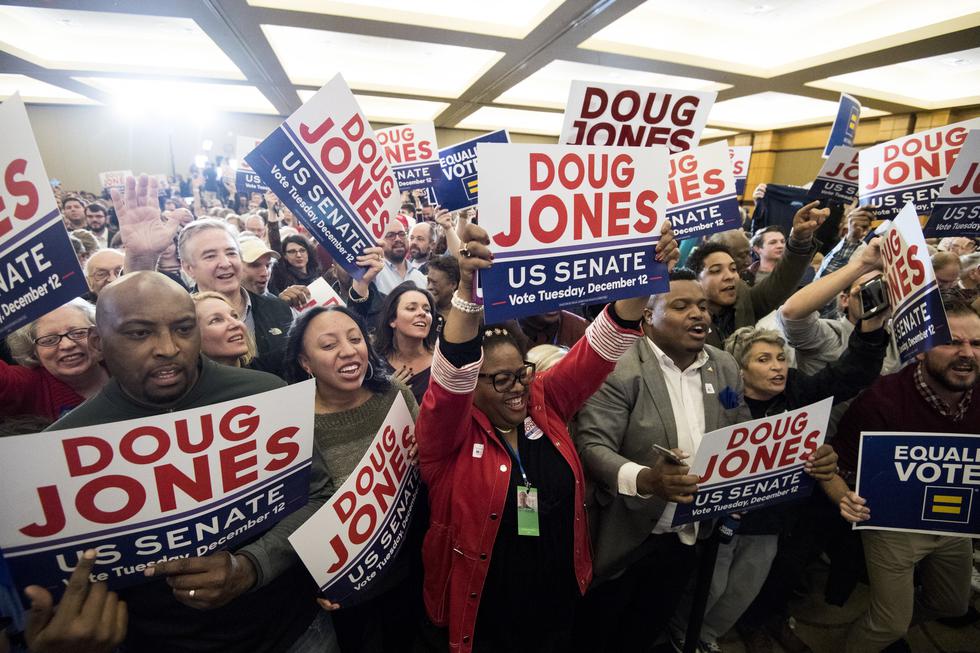
What motivated African American men and women to vote on Tuesday in Alabama was not the Democratic Party’s plight or the fate of the republic. It wasn’t Cory Booker or Deval Patrick, or Charles Barkley. It was less about Donald Trump. Doug Jones’s role in bringing two Klansmen to justice, convicting them decades after they killed four little girls at a Birmingham house of worship gave him the credibility among black voters that a generic, good-government Democrat would not have had. But it was Roy Moore and his slavery good-times minstrel show that propelled black people to the polls.
There were other tangible reasons to make the share of black votes actually higher than when Barack Obama was on the ballot in 2008 and 2012. On most election days, Americans go to the polls, cast their ballots, bid the poll workers bye-bye, and maybe grab a cookie if there’s a bake sale in the vicinity. In black Alabama, just wanting to vote, getting around the voting obstacles erected by whites, and then traveling to a polling station, are entirely different experiences.
As New York Times Magazine reporter Nikole Hannah Jones observed:
Only Mississippi can claim to have fought the voting rights of black people as violently and brutally as Alabama. That black voters delivered this victory is the worst nightmare of those who nearly beat @repjohnlewis to death in Selma. Amazing.
— Ida Bae Wells (@nhannahjones) December 13, 2017
In his 1963 “Letter from a Birmingham Jail,” written a few months before the church bombing, Dr. Martin Luther King Jr. noted that, “Throughout Alabama all sorts of devious methods are used to prevent Negroes from becoming registered voters.” In 2017, gone are the detailed application forms, literacy tests, and “voucher” system. Today the devious methods of yesteryear have gone high-tech: computer-assisted gerrymandering, photo ID requirements, and closing down motor vehicle registration offices in mostly black areas (an intent not lost on anyone in Alabama) where people could register to vote and get their photo ID.
Lest Americans forget, Alabama is also one of a handful of states where voting regulations are no longer subject to preclearance by the Justice Department or a federal court. Since the Supreme Court struck down Section 4 of the Voting Rights Act, white Alabamians no longer have to justify their injustices to a motley crew of Washington bureaucrats.
Stack up those barriers, and black Alabama still turned out in historic numbers—and showed Democrats what a real Get-Out-The-Vote effort looks like.
1.Just spoke with a source in the Mobile (AL) County NAACP. Here are some things that are happening today on the ground in Alabama that did not happen in the 2016 election. Thread:
— Al Giordano (@AlGiordano) December 12, 2017
If the Alabama NAACP isn’t energized, no one is. According to journalist Al Giordano, every local NAACP branch worked to call everyone who didn’t vote in 2016. Paid canvassers went out and billboards went up in the right places. Pastors made more effective use of church events. Other black voter mobilization groups combed the state.
Meanwhile, the Democratic National Committee took a page out of its Virginia playbook, spending more money in the field and on GOTV efforts than they did on television advertising. The Jones campaign also stepped up to fund GOTV activities sponsored by the Alabama Democratic Conference, the powerful statewide black Democratic network, led by Dr. Joe Reed, who The Intercept called the “last true black party boss in the South.”
“Teach Me How to Dougie” may be a new theme song for some after Alabama, but the Democratic Party is still a long way from controlling the White House or Congress. Former NBA star and Alabama native Charles Barkley, who once considered running for Alabama governor, had this real-world advice for over-confident Democrats: “This is more of a referendum on Alabama. … It's time for [Democrats] to get off their ass and start making life better for black folks and people who are poor,” Barkley said after the Jones victory. “They've always had our votes. … But this is a wake-up call for Democrats to do better for black people and poor white people.”
Black Alabamians know the sting of representation without results. Several days before the election, an AL.com reporter accompanied United Nations official Philip Alston, a white Australian, on a trip through Alabama’s Black Belt—because if you want to study Third World-level poverty in the First World, the United States is a good place to start. In Lowndes County, Alston saw homes surrounded by pools of raw sewage. The residents could not afford septic system repairs or upgrades. In one area of Butler County, trenches carry sewage to a stream. “A lot of people aren't being represented even though they're voting,” said one Lowndes County resident.
To stop a white man who pined for slavery from representing Alabama in Washington and to the world, black voters knocked themselves out to get out the vote. But Jones will find he’ll have a tough time. Convicting Klansmen in Alabama is hard. Dealing with Senate Republicans who refuse to negotiate with Democrats and ignore poor black and whites in Alabama and elsewhere may be harder.
The test for Doug Jones is not his commitment to civil rights. Whether black voters will do it all again in 2020 for Jones should he run for re-election (and potential opponents are already lining up) depends on how he and his fellow Democrats bridge the race and class divisions that find poor black people in a wealthy, hi-tech superpower living next to cesspools straight out of the Middle Ages.



